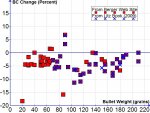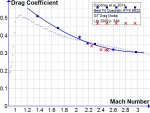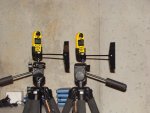Which Published Berger BCs Are From Predictions Rather than Measurements?
Both Eric Stecker and Bryan Litz give the definite impression that Berger's BCs published since 2009 or so are the result of Bryan's careful and well documented BC measurement system (using an acoustic method over 600 yards) rather than the output from any kind of predictive model.
For example, in a blog post dated 30 January 2009, Eric Stecker wrote:
A few months ago Bryan became Berger Bullet’s full time Chief Ballistician. Since Bryan has the ability to accurately measure fired BCs with +/- 1% repeatability and since we are committed to providing shooters with the best product and data it was an obvious and simple decision to update our published BCs to Bryan’s fired numbers. (Why Our BC Numbers Have Changed (Been Corrected) | Berger Bullets Blog )
Bryan Litz has written:
The first thing I did when I started working for Berger was to reassess all the advertised BC’s (which were based on computer predictions) to the actual measurements I took from live fire and averaged over long range. This resulted in an average 3% to 5% reduction in Bergers [sic] advertised numbers. I also introduced the idea of using G7 BC’s [sic] to minimize velocity effects.
The effect of the claim to have measured ALL of Berger's advertised ballistic coefficients is to give customers the impression that the likely accuracy level corresponds to the 1% or so claimed accuracy of the Litz measurement system rather than much less accurate predictive models, such as the McDrag model developed by Bob McCoy at BRL or the Litz predictive model published as equation 17.1 in his 2009 book, Applied Ballistics for Long Range Shooting.
The attached figure shows changes in Berger's advertised ballistic coefficients between 20 October 2008 (when Berger was using a predictive model attributed to Bill Davis for their BCs) and 14 April 2010 (after Berger had purportedly updated their advertised BCs to "Bryan's fired numbers" (to quote Eric Stecker). In total (counting bullets with the same shape and BC only once), the BCs of 66 bullets were updated, and the percent differences in these new BCs are shown as red squares in the graph. However, comparing with Bryan's book, Applied Ballistics for Long Range Shooting (the blue Xs) shows only 35 of the new BCs can be attributed to Bryan's experimental measurements.
Where did the new BCs for the other 31 bullets come from? The most plausible explanation seems to be that Berger re-calculated these BCs based on an "improved" predictive model (or a similar predictive model) based on equation 17.1 of Bryan's 2009 book. This model purports to have a 95% confidence level of 4.2% for boat tail bullets, but predictions for flat base bullets would likely be much less accurate.
One reason I lean toward this possibility is because the 115 grain .257 VLD had its BC advertised at 0.479 at the Berger site on 6 February 2009, and I received two boxes of these bullets with this BC printed on them at about that time. However, in Bryan's 2009 book and later on the Berger site, the BC was revised to 0.466. When I asked him about these differences, Bryan explained that the BC value of 0.479 had been based on a predictive model and used temporarily until the BC could actually be measured with his method. I think several other bullets (like the 87 grain .257 bullet) whose advertised BCs were changed twice between 10/26/2008 and 2/6/2009 and 4/14/2010 may have also had the intermediate value based on a predictive model later changed to a model based on measurement. It is certainly possible that all 66 bullets were updated based on actual measured BCs, but it is also possible that some bullet BCs were updated based on a predictive model and have still not been updated based on real measurement results.
It may be notable that while most of the bullets whose revised BCs seem to be based on a predictive model have BC adjustments under 5%, 16 of the 35 or 36 bullets that seem to be based in actual firing measurements have been adjusted downward by over 5%. Other than a 17 cal bullet, the biggest downward adjustments were the 87 grain .257 (-15.85%), the 115 grain .257 (-10.9%), and the 105 grain .243 VLD (-11.33%).
Now this may seem like so much ancient history, except that, for the bullets still in the Berger catalog, nearly all of the 30-31 bullets whose revised BC seems more likely based on a predictive model than actual firing measurements have had their advertised BCs unchanged since 14 April 2010.
In light of these concerns, I think Berger owes the shooting community some quick and honest answers regarding which of their currently advertised BCs have actually been measured by live firing and which are attributable to a less accurate predictive model. After all, Eric Stecker is on record as saying:
A BC is not a marketing tool and should not be inflated (intentionally or by using inaccurate means to calculate BC) for the purposes of selling more bullets. Some will say that inflating BC is smart business but frankly, we do not agree. A BC is an important number with physical meaning that’s used to calculate the trajectory of a given bullet which enables shooters to reliably engage targets at long range. The BC should allow a shooter to hit their aim point each and every time. There are many factors that influence the location of bullet impact but an accurate BC number is an essential component in achieving the most successful shooting experience no matter which brand you shoot. The bullet makers owe it to the shooters to provide them with truly accurate information about the performance of their product and that’s what we’re committed to.
When Berger was asked directly in 2014 whether the BCs of two specific varmint bullets had been measured directly or resulted from a predictive model, Eric Stecker hinted but dod not answer directly:
I won't say that we don't have a few FB bullets that need closer review but the varmint bullets are not our priority. Anything with a BT has been thoughroly tested.
Links to past Berger BC specs:
Berger Bullets - All Bullets
Berger Bullets - All Bullets
Berger Bullets
Both Eric Stecker and Bryan Litz give the definite impression that Berger's BCs published since 2009 or so are the result of Bryan's careful and well documented BC measurement system (using an acoustic method over 600 yards) rather than the output from any kind of predictive model.
For example, in a blog post dated 30 January 2009, Eric Stecker wrote:
A few months ago Bryan became Berger Bullet’s full time Chief Ballistician. Since Bryan has the ability to accurately measure fired BCs with +/- 1% repeatability and since we are committed to providing shooters with the best product and data it was an obvious and simple decision to update our published BCs to Bryan’s fired numbers. (Why Our BC Numbers Have Changed (Been Corrected) | Berger Bullets Blog )
Bryan Litz has written:
The first thing I did when I started working for Berger was to reassess all the advertised BC’s (which were based on computer predictions) to the actual measurements I took from live fire and averaged over long range. This resulted in an average 3% to 5% reduction in Bergers [sic] advertised numbers. I also introduced the idea of using G7 BC’s [sic] to minimize velocity effects.
The effect of the claim to have measured ALL of Berger's advertised ballistic coefficients is to give customers the impression that the likely accuracy level corresponds to the 1% or so claimed accuracy of the Litz measurement system rather than much less accurate predictive models, such as the McDrag model developed by Bob McCoy at BRL or the Litz predictive model published as equation 17.1 in his 2009 book, Applied Ballistics for Long Range Shooting.
The attached figure shows changes in Berger's advertised ballistic coefficients between 20 October 2008 (when Berger was using a predictive model attributed to Bill Davis for their BCs) and 14 April 2010 (after Berger had purportedly updated their advertised BCs to "Bryan's fired numbers" (to quote Eric Stecker). In total (counting bullets with the same shape and BC only once), the BCs of 66 bullets were updated, and the percent differences in these new BCs are shown as red squares in the graph. However, comparing with Bryan's book, Applied Ballistics for Long Range Shooting (the blue Xs) shows only 35 of the new BCs can be attributed to Bryan's experimental measurements.
Where did the new BCs for the other 31 bullets come from? The most plausible explanation seems to be that Berger re-calculated these BCs based on an "improved" predictive model (or a similar predictive model) based on equation 17.1 of Bryan's 2009 book. This model purports to have a 95% confidence level of 4.2% for boat tail bullets, but predictions for flat base bullets would likely be much less accurate.
One reason I lean toward this possibility is because the 115 grain .257 VLD had its BC advertised at 0.479 at the Berger site on 6 February 2009, and I received two boxes of these bullets with this BC printed on them at about that time. However, in Bryan's 2009 book and later on the Berger site, the BC was revised to 0.466. When I asked him about these differences, Bryan explained that the BC value of 0.479 had been based on a predictive model and used temporarily until the BC could actually be measured with his method. I think several other bullets (like the 87 grain .257 bullet) whose advertised BCs were changed twice between 10/26/2008 and 2/6/2009 and 4/14/2010 may have also had the intermediate value based on a predictive model later changed to a model based on measurement. It is certainly possible that all 66 bullets were updated based on actual measured BCs, but it is also possible that some bullet BCs were updated based on a predictive model and have still not been updated based on real measurement results.
It may be notable that while most of the bullets whose revised BCs seem to be based on a predictive model have BC adjustments under 5%, 16 of the 35 or 36 bullets that seem to be based in actual firing measurements have been adjusted downward by over 5%. Other than a 17 cal bullet, the biggest downward adjustments were the 87 grain .257 (-15.85%), the 115 grain .257 (-10.9%), and the 105 grain .243 VLD (-11.33%).
Now this may seem like so much ancient history, except that, for the bullets still in the Berger catalog, nearly all of the 30-31 bullets whose revised BC seems more likely based on a predictive model than actual firing measurements have had their advertised BCs unchanged since 14 April 2010.
In light of these concerns, I think Berger owes the shooting community some quick and honest answers regarding which of their currently advertised BCs have actually been measured by live firing and which are attributable to a less accurate predictive model. After all, Eric Stecker is on record as saying:
A BC is not a marketing tool and should not be inflated (intentionally or by using inaccurate means to calculate BC) for the purposes of selling more bullets. Some will say that inflating BC is smart business but frankly, we do not agree. A BC is an important number with physical meaning that’s used to calculate the trajectory of a given bullet which enables shooters to reliably engage targets at long range. The BC should allow a shooter to hit their aim point each and every time. There are many factors that influence the location of bullet impact but an accurate BC number is an essential component in achieving the most successful shooting experience no matter which brand you shoot. The bullet makers owe it to the shooters to provide them with truly accurate information about the performance of their product and that’s what we’re committed to.
When Berger was asked directly in 2014 whether the BCs of two specific varmint bullets had been measured directly or resulted from a predictive model, Eric Stecker hinted but dod not answer directly:
I won't say that we don't have a few FB bullets that need closer review but the varmint bullets are not our priority. Anything with a BT has been thoughroly tested.
Links to past Berger BC specs:
Berger Bullets - All Bullets
Berger Bullets - All Bullets
Berger Bullets





